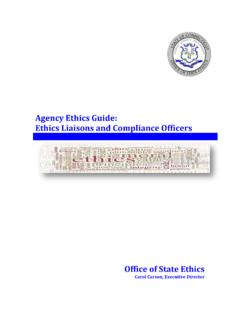Transcription of Retirement Benefits for Federal Law Enforcement Personnel
1 Retirement Benefits for Federal Law Enforcement Personnel Katelin P. Isaacs Acting Section Research Manager September 5, 2017 Congressional Research Service 7-5700 R42631 Retirement Benefits for Federal Law Enforcement Personnel Congressional Research Service Summary Federal employees who perform specific duties , as defined in statute, are classified as law Enforcement officers (LEOs) for the purpose of Federal Retirement Benefits . LEOs and a few legislatively designated groups, including Federal firefighters and air traffic controllers, are eligible for enhanced Retirement Benefits under the Civil Service Retirement System (CSRS), for individuals hired before 1984, or the Federal Employees Retirement System (FERS), for individuals hired in 1984 or later.
2 The availability of enhanced Retirement Benefits for LEOs and similar groups is linked to an expectation of limited Federal service. This limited service is due, in turn, to the rigorous physical demands of law Enforcement duties and the mandatory Retirement age to which these individuals are subject. LEO enhanced Retirement Benefits are designed to provide adequate Retirement income for Federal employees with careers that end at an earlier age with fewer years of service than regular civilian Federal employees. In general, law Enforcement Personnel are subject to mandatory Retirement at age 57, or as soon as 20 years of service have been completed after age 57.
3 The maximum age of entry, which is intended to ensure full Retirement Benefits upon reaching mandatory Retirement age, is typically age 37. Under both CSRS and FERS, law Enforcement Personnel are eligible for their enhanced Benefits at the age of 50 provided they have completed the minimum requirement of 20 years of service. Under FERS, law Enforcement Personnel with 25 years of service are eligible for Retirement regardless of age. Law Enforcement Personnel in CSRS and their employing agencies each contribute of payroll. CSRS law Enforcement Personnel accrue Benefits at the rate of per year for their first 20 years of service and 2% for each year after the 20th year of service.
4 Law Enforcement Personnel in FERS accrue Benefits at the rate of per year for the first 20 years of service and 1% per year for each year thereafter. FERS contribution rates vary by date of hire. Law Enforcement Personnel in FERS first hired before 2013 contribute of pay (plus Social Security contributions), and their agencies contribute of pay. Under 112-96, FERS law Enforcement Personnel first hired in 2013 contribute of pay (plus Social Security contributions), and their agencies contribute of pay. Finally, under 113-67, FERS law Enforcement Personnel first hired in 2014 or later contribute of pay (plus Social Security contributions), but their agencies still contribute of pay.
5 FERS accrual rates remain unchanged for law Enforcement Personnel first hired in 2013 or later (including individuals first hired in 2014 or later). Many employees in law Enforcement occupations are not recognized as LEOs by their agencies and OPM for the purposes of Federal Retirement coverage and, consequently, are not eligible to receive enhanced Retirement Benefits . Several employee groups and unions representing individuals in these occupations have sought enhanced Retirement Benefits through additional legislation. Recent Congresses have responded by introducing legislation that would provide enhanced Retirement Benefits to additional Personnel . Though granting more groups such Benefits may alleviate problems of attrition and perceived inequity across law Enforcement occupations, it would also increase Personnel costs for employing agencies as well as overall Federal expenditures on civilian Federal Retirement Benefits .
6 Retirement Benefits for Federal Law Enforcement Personnel Congressional Research Service Contents Introduction .. 1 Federal Law Enforcement Officers and Related Personnel .. 1 Statutory Definition of a Law Enforcement 1 Additional Regulations Defining LEOs .. 2 Administrative Process for Determining LEO Status .. 2 Legislative Rationale for Enhanced Retirement Benefits .. 4 Retirement Coverage for Federal Law Enforcement Personnel .. 5 Civil Service Retirement System .. 5 Federal Employees Retirement 5 Eligibility and Benefit Amounts Under CSRS and FERS .. 6 Age and Length of Service Requirements .. 6 Mandatory Retirement .. 6 Maximum Age of Entry .. 6 Minimum Retirement Age.
7 7 Required Contributions .. 7 Contributions Under CSRS .. 7 Contributions Under FERS .. 7 Pension Plan Benefits .. 8 High-Three Average Salary .. 8 Accrual Rates .. 8 Pension Formulas .. 8 Federal Law Enforcement Personnel with Both CSRS and FERS Coverage .. 9 The FERS Supplement .. 9 Cost-of-Living Adjustments .. 9 Replacement Rates .. 10 Extending Enhanced Benefits to Other Occupational Groups .. 12 Tables Table 1. Major Occupational Groups Eligible for Enhanced Benefits .. 3 Table 2. Major Occupational Groups Added to the Definition of a LEO or Provided with LEO-Equivalent Benefits via Direct Legislation .. 3 Table 3. Summary of Retirement Benefits for Federal Law Enforcement Personnel .
8 11 Contacts Author Contact Information .. 13 Retirement Benefits for Federal Law Enforcement Personnel Congressional Research Service 1 Introduction Federal law Enforcement officers, as defined in statute, and a few related occupations such as Federal firefighters and air traffic controllers are eligible for enhanced Retirement Benefits . Congress decided that these occupations should be composed of young men and women who possess the strength and endurance necessary to perform the required duties . Enhanced Retirement Benefits help to maintain this type of workforce by permitting employees in these positions to retire earlier and accrue pension Benefits faster during earlier years of service than regular civilian Federal employees.
9 Many individuals and employee groups who work in law Enforcement -related positions, but who have not qualified as law Enforcement officers for Retirement purposes, have sought enhanced Benefits through legislation in recent Congresses. Incorporating additional occupations may address problems of attrition and perceived inequity across law Enforcement -related positions. However, expanding access to enhanced Retirement Benefits also generates concerns over additional expenditures on Federal Retirement Benefits . Federal Law Enforcement Officers and Related Personnel Currently, the definition of a Federal law Enforcement officer (LEO) for Retirement purposes is limited to an employee who performs certain duties defined in statute under either the Civil Service Retirement System (CSRS), which covers Federal employees hired before 1984, or the Federal Employees Retirement System (FERS), which covers Federal employees hired in 1984 or later.
10 Individuals employed in positions that meet the statutory definition of a LEO, as well as certain Personnel who have obtained LEO-equivalent Benefits through direct legislation, are eligible to retire earlier with fewer years of service and receive a benefit accrual rate during the first 20 years of service that is higher than the benefit accrual rate for regular Federal civilian employees. LEOs and employees who have enhanced Retirement Benefits also contribute more to their own Benefits than regular civilian Federal employees and are subject to a mandatory Retirement age. Statutory Definition of a Law Enforcement Officer Under CSRS, a LEO is an employee whose primary duties are the investigation, apprehension, or detention of individuals suspected or convicted of offenses against the criminal laws of the United States, including an employee engaged in this activity who is transferred to a supervisory or administrative position.
















